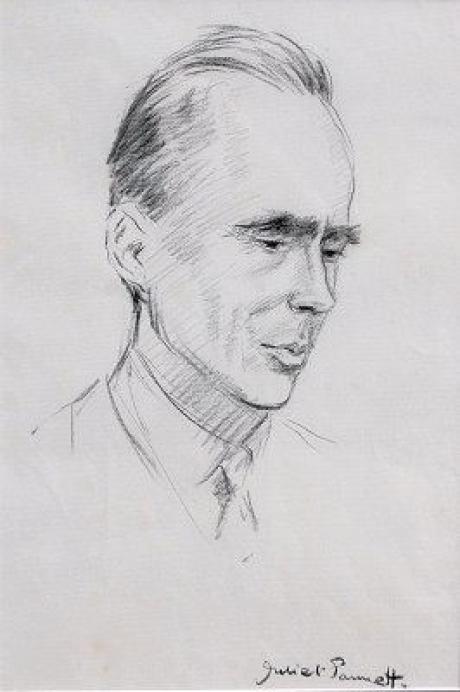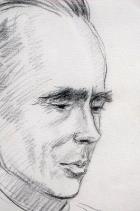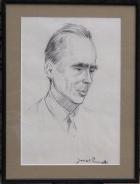Juliet Pannett and further inscribed on a label on the reverse " Group Captain Leonard Cheshire VC, / Drawn at 7 market Mews W1 28th April 61".
Group Captain Geoffrey Leonard Cheshire, Baron Cheshire, VC, OM, DSO and 2 Bars, DFC (7 September 1917–31 July 1992) was a British RAF pilot during the Second World War who received the Victoria Cross, the highest and most prestigious award for gallantry in the face of the enemy that can be awarded to British and Commonwealth forces. After the war he became a charity worker, setting up "The Cheshire Foundation Homes for the Sick" for disabled people (to become later, The Leonard Cheshire Foundation and simply 'Leonard Cheshire'), Leonard Cheshire Centre for Conflict Recovery, Ryder-Cheshire Foundation, Ryder-Cheshire Volunteers and The Memorial Fund for Disaster Relief. His final battle was his courageous struggle with the debilitating effects of Motor Neurone Disease.
Leonard Cheshire was the son of Professor Geoffrey Chevalier Cheshire, DCL, LLD, FBA, a barrister, academic and influential writer on English law and brother to Christopher Cheshire, a pilot. Cheshire was born in Chester but was brought up at his parents' home near Oxford. He was educated at the Dragon School, Oxford, Stowe School and Merton College, Oxford. He graduated in Jurisprudence in 1939.After the outbreak of the World War II, Cheshire applied for a commission in the Royal Air Force and was initially posted in June 1940 to 102 Squadron, flying Whitley medium bombers. In November 1940 he was awarded the DSO for flying his badly damaged bomber back to base.In January 1941 he completed his tour of operations but then volunteered straight away for a second tour. He was posted to No. 35 squadron with the brand new Handley Page Halifax, and completed his second tour early in 1942, by now a Squadron Leader. August 1942 saw a return to operations as CO of 76 Squadron. The Squadron had recently suffered high losses operating the Halifax, and Cheshire immediately tackled the low morale of the unit by ordering an improvement in the performance of the squadron aircraft by removing the mid-upper and nose turrets, exhaust covers and other weighty non-essential equipment. This allowed the bombers to fly higher and faster. Losses soon fell and morale rose accordingly. Cheshire became Station OC RAF Marston Moor in March as the youngest Group Captain in the RAF, though the job was never to his liking and he pushed for a return to an operational command. These efforts paid off with a posting to succeed Wing Commander Guy Gibson as commander of the legendary 617 Dambusters Squadron in the September of 1943.
While with 617 Cheshire helped pioneer a new method of marking enemy targets for Bomber Command's 5 Group, flying in at a very low level in the face of strong defences, using first the versatile Mosquito, then a 'loaned' P-51 fighter. This development work was the subject of some severe inter-service politics, as Cheshire was encouraged by his Group's Commander Air Vice-Marshal Ralph Cochrane, although the Pathfinder AOC Air Vice-Marshal Don Bennett saw this work as impinging on the work of his own squadrons.Cheshire was nearing the end of his fourth tour of duty in July 1944, having completed a total of 102 missions, when he was awarded the VC. He was the only one of the 32 VC airmen to win the medal for an extended period of sustained courage and outstanding effort, rather than a single act of valour. His citation read;
'In four years of fighting against the bitterest opposition he maintained a standard of outstanding personal achievement, his successful operations being the result of careful planning, brilliant execution and supreme contempt for danger - for example, on one occasion he flew his P-51 Mustang in slow figures of 8 above a target obscured by low cloud, to act as a bomb-aiming mark for his squadron. Cheshire displayed the courage and determination of an exceptional leader.'
Cheshire was, in his day, both the youngest Group Captain in the service and, following his VC, the most decorated. His notable wartime record makes his subsequent career all the more remarkable.On his 103rd mission, he was official British observer of the nuclear bombing of Nagasaki flying in the support B-29 The Great Artiste, an event which profoundly changed him. On his return from the mission he left the RAF and went home to his house, Le Court in Hampshire.While deciding what he should do with the rest of his life he heard about the case of Arthur Dykes, who had been one of Leonard's original 'VIP' community at Le Court, Hampshire and was suffering from cancer. Dykes asked Cheshire to give him some land to park a caravan until he recovered, but Cheshire discovered that Dykes was terminally ill and that this fact had been concealed from him. He told Dykes the real position and invited him to stay at Le Court.
Cheshire learned nursing skills and was soon approached to take in a second patient, the 94-year-old bedridden wife of a man whose own frailness meant he could no longer care for her himself. She was followed by others, some coming to stay and others to help. Although Le Court had no financial support, and was financially perilous most of the time, money somehow always seemed to arrive in the nick of time to stave off disaster. By the time Arthur Dykes died in 1948, there were 24 people staying at Le Court.
On Dykes's death, Cheshire, a lapsed Christian but one whose faith had been stirring for a while, sat by his bed and picked up the Bible. Soon afterwards he converted to the Roman Catholic Church.
Cheshire dedicated the rest of his life to working for the disabled and terminally ill, combining this with lecturing on conflict resolution.
In 1948, he founded 'The Cheshire Foundation Homes for the Sick' which in 1976 became the Leonard Cheshire Foundation charity, now styled "Leonard Cheshire", which continues his work. It provides support to disabled people through a variety of different services including care at home, residential care and training and developing to disabled people throughout the world. It is described on its factsheet as "the UK’s leading voluntary sector provider of support services for disabled people"
On 15 July 1941 Cheshire married an American actress, Constance Binney, but this marriage was short-lived. Then, on 5 April 1959, in Mumbai's Catholic Cathedral, he married Sue Ryder, also the founder of a charity. From this marriage he had two children, Jeromy and Elizabeth Cheshire.
In 1991 he was given a life peerage, sitting as a cross-bencher. He lived through his final illness (Motor Neurone Disease) with exemplary spiritual fortitude. Queen Elizabeth II paid personal tribute to him in her Christmas message to the Commonwealth in December 1992. In the 2002 BBC poll to find the 100 Greatest Britons, Cheshire attained position 31. His Victoria Cross is displayed at the Imperial War Museum (London, England).
Former Pink Floyd member Roger Waters once described Cheshire as "the only true Christian I've ever met".
British VCs of World War 2 (John Laffin, 1997)
Cheshire : The biography of Leonard Cheshire, VC, OM (Richard Morris, 2000)
Cheshire, V.C. (R. Bradon, 1954)
The Dam Busters (Paul Brickhill, 1983)
Monuments To Courage (David Harvey, 1999)
No Passing Glory (Andrew Boyle)
The Register of the Victoria Cross (This England, 1997)
Antoni Chmielowski
Crossing the Finishing Line – Last Thoughts of Leonard Cheshire VC, ed. Reginald C. Fuller (London 1998).
The Times, 28 Oct 1978, Obituary: Professor G.C. Cheshire—Influential writer on the law
Born in Hove, East Sussex, Pannett started painting at three, and wanted to be a professional artist by seventeen. She trained at Brighton College of Art in the 1920s under Louis Ginnett, and received her first artistic commission at eighteen to draw local Sussex characters for the Sussex County Magazine. Pannett maintained a studio in Hove and was elected a member of the Society of Graphic Artists in 1934. She was a professional artist until her marriage in 1938.
Pannett married Major Rick Pannett who had been injured in the First World War when he was shot in the mouth. The bullet had pierced his cheek and missed all his bones.Pannett gave up painting after the birth of her children. Suffering from depression, it was alleviated when she resumed painting. In 1949 the family moved to Croydon where she built a studio in her garage. The Pannett family later moved to Angmering in Sussex in 1964.
Among her subjects were Field-Marshal Montgomery, film director Jean Cocteau, athlete Chris Chataway, Louis Armstrong and Leonard Bernstein. Pannett was a keen cricketer and drew such cricketers as Maurice Tate and Bob Wyatt. Pannett preferred to paint men rather than women, describing men as she found them "less troublesome as sitters...They never ask me not to put in their double chin or to leave out their wrinkles."
Before the televised proceedings of the House of Commons Pannett was employed by the Illustrated London News from 1957 to 1964 to sketch the events of the House. Sitting in the gallery of the Commons Pannett drew such historically significant events as Winston Churchill's last appearance in the house in 1964. Pannett later formally drew several other British Prime Ministers, including Alec Douglas-Home, who told her that he had "the biggest head in London" and could never find a hat to fit him. Later Prime Ministers painted by Pannett included Edward Heath, James Callaghan and Margaret Thatcher.
For several years around 1960, Pannett supplied the Radio Times with drawings of musicians and other figures being broadcast on BBC radio. In February 1963, she was commissioned by The Illustrated London News to do several sketches of C. S. Lewis.
She painted Queen Elizabeth II in 1989 for the Chartered Insurance Institute. Pannett had previously drawn Princes Andrew and Edward. Upon seeing the portrait Prince Philip commissioned a pastel drawing from her of the Queen for the 25th anniversary of the Independence of Malta.
Due to her failing eyesight her last major portrait was of General Sir John Wilsey.She was appointed an MBE in 1993, and was a member of the Pastel Society and a fellow of the Royal Society of Arts and an Honorary Freeman of the Worshipful Company of Painter-Stainers, who awarded her their gold medal in 1995.
At the time of her death in 2005 she was the oldest living artist to have work in the National Portrait Gallery's collection. Her husband had died in 1980, she was survived by her two children, who are both artists.
Her autobiography, My Colourful Life was published in 2006.



